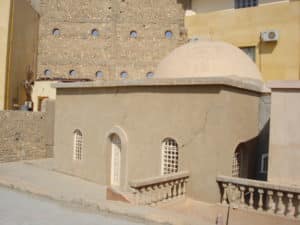 Starting from the 8th century until the 11th century, most of the patriarchs of the Church of Alexandria were originally monks of the Monastery of St. Macarius. It thus became a sort of “second” papal residency in which the patriarch used to spend a lot of time during the year, especially during the Great Lent and the Week of Pascha (Holy Week). The patriarchs have always had, at last since the 7th century, a personal cell in the monastery of St Macarius called “the Patriarch’s cell” in which he used to spend his time in the monastery. Even today, what is thought to be a historical patriarchal cell is preserved and is used as a sacristy for the main church of St Macarius.
Starting from the 8th century until the 11th century, most of the patriarchs of the Church of Alexandria were originally monks of the Monastery of St. Macarius. It thus became a sort of “second” papal residency in which the patriarch used to spend a lot of time during the year, especially during the Great Lent and the Week of Pascha (Holy Week). The patriarchs have always had, at last since the 7th century, a personal cell in the monastery of St Macarius called “the Patriarch’s cell” in which he used to spend his time in the monastery. Even today, what is thought to be a historical patriarchal cell is preserved and is used as a sacristy for the main church of St Macarius.
Probably, the first and most important account that witnesses this epochal turning point in the history of the Church is the consecration of the sanctuary of St Macarius by the Patriarch Benjamin I (623-662). His travel to the monastery testifies the close connection that this particular monastery would have with the patriarchate over the coming centuries.
The Monastery of St Macarius had already served as a refuge for exiled patriarchs from the time of Theodosius on, and under the Arabs the connection between the monastery and the patriarch would become firmer. Most of the patriarchs from the mid-eighth to the mid-eleventh century—specifically from pope Michael I (743-767) to Shenoute II (1032-1046)—came from the Monastery of St. Macarius, and even later the monastery had a key role in consecrating the patriarch.
This information is important to understand why the consecration of the myron (better known in the West as “chrism”) for the whole Church of Alexandria took place for almost nine centuries (until 1330) at the Monastery of St. Macarius (with some exceptions). We know for example, from one of the Books of the Holy Myron—which provided liturgical details of the consecration rite but also historical documentation—that on Maundy Thursday of the year 1305 at the Monastery of St. Macarius, Patriarch John VIII and the eighteen assembled bishops donned black robes
and they went up to the cell of the myron. They took with them twelve priest-monks, each holding a censer, and twelve deacons carrying crosses and candles, and the patriarch and the bishops carried the myron and the kallielaion… They went down from the cell and came to the Sanctuary of Mark, while the deacons chanted hymns ahead of them.[1]

